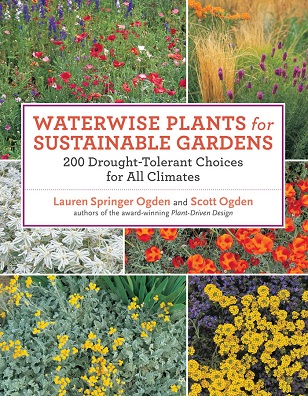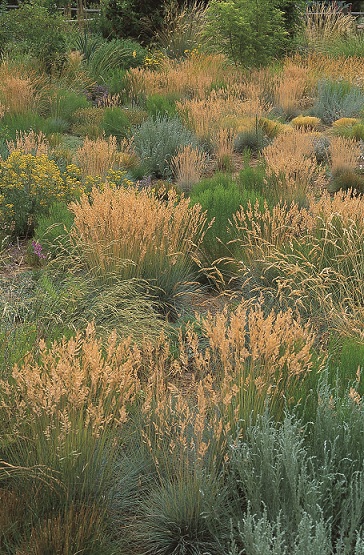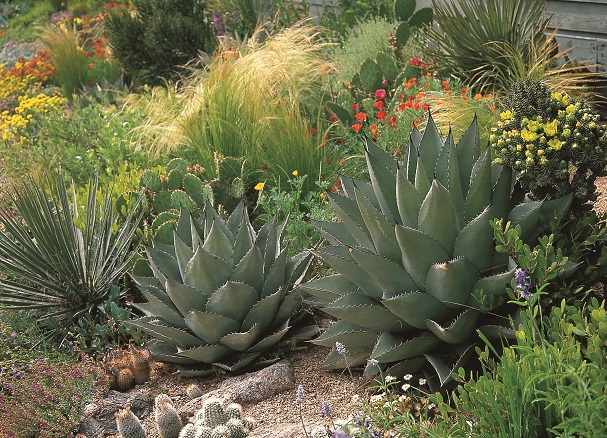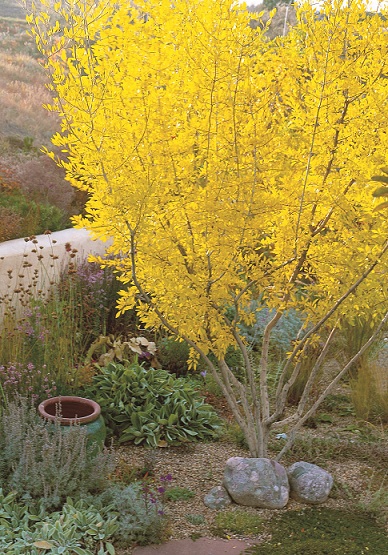Read This: Waterwise Plants for Sustainable Gardens
The ongoing drought in Texas has focused the attention of gardeners, and homeowners in general, on making smarter, more sustainable choices in the garden: using plants that need less water, reducing or eliminating thirsty lawns, and embracing a more open, xeric aesthetic. These considerations, while vital here, are becoming increasingly important even to gardeners in wetter regions. In fact, conserving water and gardening with a lighter touch on the earth are aspects of the green movement sweeping the entire country.
However, many people aren’t aware of the variety of water-thrifty plants available to them. Is a cactus what springs to mind when you hear the terms “drought-tolerant” or “xeric?” If so, Waterwise Plants for Sustainable Gardens: 200 Drought-Tolerant Choices for All Climates, a new book by Lauren Springer Ogden and Scott Ogden, will put that notion to rest. The Ogdens, a husband-and-wife team who divide their time between Austin and Colorado, have an appreciation for any plant that thrives in low-water conditions, from whatever part of the world. They’ve chosen plants not only for the Southwest and mild Mediterranean climates along the West Coast but for more temperate regions as well (up to zone 4). Their criteria? Each of their selections must “[w]hen fully established…remain attractive with just 1 inch of water (rain or irrigation) every two weeks during the hottest part of peak growing season.” Cooler seasons allow these plants to get by on even less water. (One inch of rain every two weeks is, of course, considerably more than Central Texas received last summer, so keep in mind that not all of the book’s selections are equally drought-tolerant, and some will require supplemental watering during drought.)
Two hundred low-water plants are officially profiled here, but for nearly each one the authors suggest additional related plants that may tolerate different conditions, which is especially useful if a profiled plant isn’t suitable for your region. Numerous species are included in each chapter, organized by type of plant: trees, shrubs and sub-shrubs, perennials, ground covers, grasses and sedges, bulbs, vines, annuals, succulents and cacti, palms and cycads, and fiber plants (including yucca, agave, and sotol). The photos are very good. Each profiled plant is shown off in at least one image and sometimes two. I like that most of the images are not macros but wider views that show the entire plant.
What sets this book apart from many xeric plant guides are the extras that the Ogdens include in their listings: humidity tolerance, which is crucial information for gardeners in the Southeast, Gulf Coast, and Central Texas, regions that endure hot, often droughty summers but also are blessed cursed with plenty of sticky humidity; how best to use each plant—for instance, against masonry walls, or along paths for fragrance; and suggested plant pairings for both sun and shade/part shade.
Waterwise Plants is a useful guide for anyone who wants to plant low-water gardens. It’s certainly a great resource for Austin gardeners. Not all of the plants listed here are suited to our intense summer heat and humidity, but plenty are, and the design suggestions will give you lots of ideas on combining them with other plants and siting them to advantage in your garden.
Want more? To read my review of the Ogdens’ book Plant-Driven Design, click here.
Photos by Lauren Springer Ogden, courtesy of Timber Press. Disclosure: This book was sent to me for review by Timber Press. My review, like everything in Digging, is my own honest opinion.
All material © 2006-2012 by Pam Penick for Digging. Unauthorized reproduction prohibited.






Great review Pam, and the gorgeous photos certainly go a long way to dispelling the notion that water-wise means desert…(if anyone still feels that way).
I think a lot of people do still believe that, Loree, including many in Austin who equate xeriscape with rocks and a few agaves. There’s so much more that they can do! Not that I have a problem with rocks or agaves, of course. —Pam
Nice review on a book already on my wish list. I wanted to link your post to my Facebook page but I couldn’t see a way to do that direct from your site. I’ve had to do that via Blotanical.
Thanks for sharing a link to my review on Blotanical, Karen! I’m sorry I don’t have a share button on my blog; I’ll look into that. But I do have a Facebook page for Digging, and it’s easy to share links to posts there if you’ve “liked” the page. —Pam
For a book to cover such a large area, it looks promising to build on their last book’s foundation, which was mostly good. Their premise of 26″ precip/yr to make the plant cut, is nice…that’s good for much of the US, though still much wetter than *every* year in the desert SW. But still way less than common irrigation practices or habitual water-hog plants! And much of the US population lies in USDA Z 4 and warmer, and is within 10-15″ of their precip target.
But that “sustainable” buzzword…hmmm. People’s practices are more crucial to that concept than plants themselves, so I hope their treatment is beyond the surface, unlike many other books and articles. I may have to get it.
I look forward to your review, David. As you note, the authors are reaching out to a much broader audience with this book than just the desert SW, which is probably already well served by plant guides. I think it will be particularly of use where recurring drought is a serious concern—places that are used to plenty of water either from the sky or from the tap (like Austin, or the Southeastern U.S.) but that are having to face up to a new reality. —Pam
I forgot to add – your comment on the book noting humidity tolerance for each plant seems useful, too. Their living in both northern Colorado and Austin must help to provide such a perspective…
Exactly, David. In fact, Scott Ogden said the same thing to me in a recent email: he and Lauren garden in two extreme climates, both semi-arid; differences are altitude, length and intensity of summer/winter, and humidity levels. The result is a unique perspective and plenty of experience with waterwise gardening. —Pam
Sounds like a great book! Especially for the people in Texas are are rethinking their gardening!
Yes, Candy, I do think Texas gardeners will find it of particular interest. I know I did. —Pam
Love anything Ogden does. I dug out an old book I purchased 20 years ago the other day: gardening success with difficult soils by scott ogden. I would imagine that this new book will be very interesting. Thanks for sharing a review. The humidity tolerances will be interesting to read.
Between the two of them, they are quite prolific authors. Aside from Plant-Driven Design and this book, I have one other of Scott’s books, The Moonlight Garden. I’d like to read more of theirs. —Pam
Pam-
Thanks for your generous review; nice choice of Lauren’s pictures, too! We want to clarify briefly and respond to David’s post regarding our premise for irrigating. By our calculations the varieties we’ve mentioned in our book will require less than 26″ water per year in nearly all climates. David’s calculation would apply only in a climate with year round warm growing conditions and zero effective rainfall. In places like Austin or Albuquerque we would expect to need 2″ every 4 weeks through a 30-week warm growing season (15″) plus about 1″ every 4 weeks during the cooler part of the year (5.5″ over 22 weeks) for a total of 20.5″as a sum of irrigation and available effective natural rainfall. That said, all plants in the book will also do well with considerably more water and many were chosen in part because they succeed with humidity and occasional wet periods as well as drought. As we were all reminded this summer in Austin as well as in New Mexico, even our native plants require some assistance with irrigation during severe drought.
Thanks for the additional information about water requirements, Lauren and Scott! —Pam
Looks very interesting…and I agree with Loree…those gorgeous photos do A LOT to persuade people who may have a more limited view of water-wise gardening. I’m planning on pulling up my front hell-strip this spring, and have mostly already planned what I’m planting, but I may just pick this up to see if maybe there are some better ideas out there 🙂
I’m pulling up more grass this spring (or winter) too, Scott. I’m sure the book would give you some good ideas. It’s already given me some. —Pam
L & S – thx, now it makes sense – I missed that! That’s an even better target…I’m in the “wet” part of Abq, so 20.5″ / yr water, less my 11″ avg annual precip = 9.5″ irrigation…in 2011, that would still only be 12″ irrig. That’s is similar to what I’ve told most clients for 20+ years, as to what I am designing for. Nice to see it quantified…and great how plants were chosen to take the deluge-to-drought swing.
Thanks for the heads-up. We seem to be transitioning into drier summer and fall weather than we had when much of our garden was first planted. I’m afraid most of us need to be looking at this book (And kudos on the mag article).
The climate does seem to be changing all over, Linda. I hope the book proves useful for you in Wisconsin. —Pam
One of my favorite passages out of the many garden books i’ve read is the first couple pages of Chapter 1 of “Garden Bulb’s of the South” by Scott Ogden. I’ve not read this book yet but I will order it right away.
I haven’t read Garden Bulbs of the South, Bill, though it seems to be the most well known of Scott’s books. I’ll have to check it out and see what I’m missing. —Pam
Thanks for posting this book review along with photos of how striking xeric landscapes can be. I will be looking for the Ogdens’ latest book to add to my collection of USEFUL gardening books. I couldn’t resist posting a link to this on my FB page & hope that this will bring addition recognition & discussion of being more water wise.